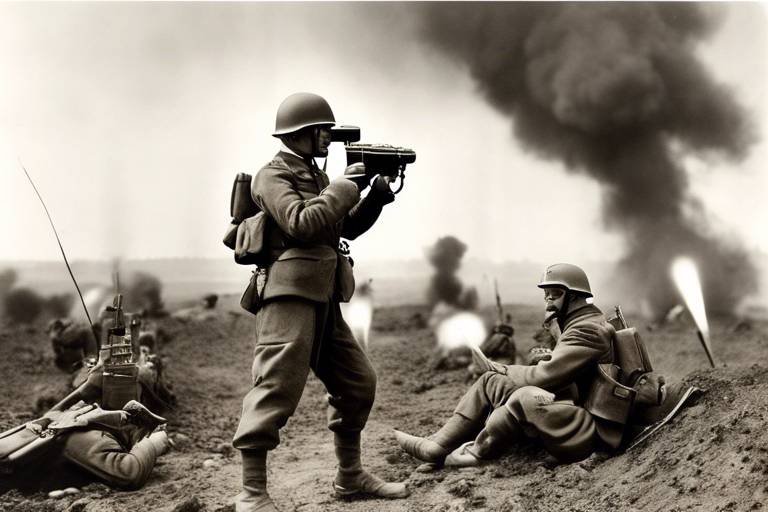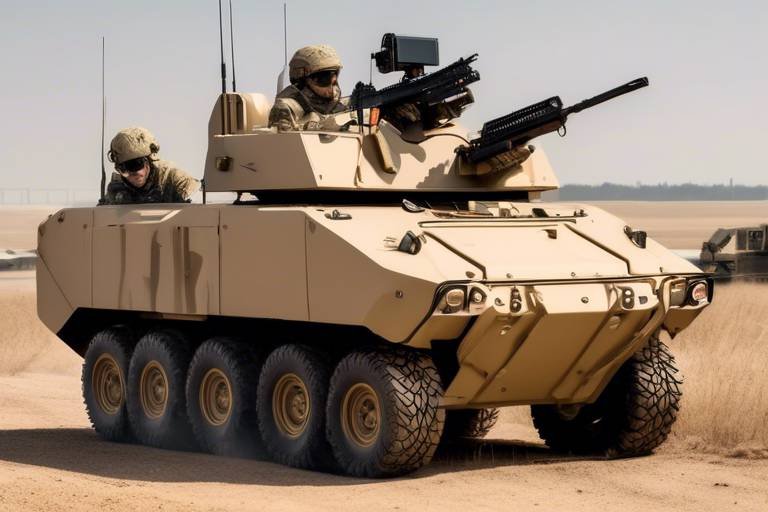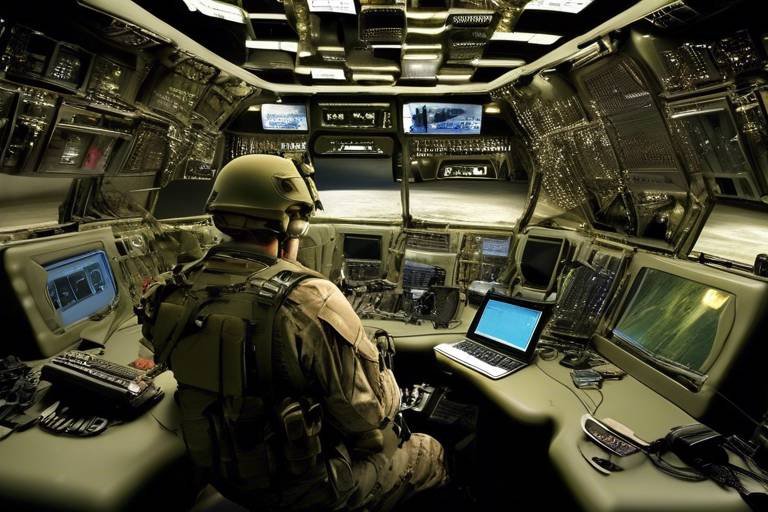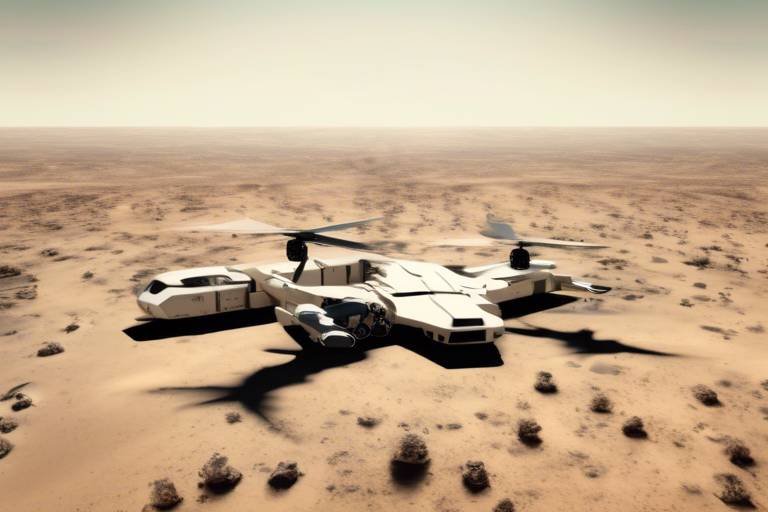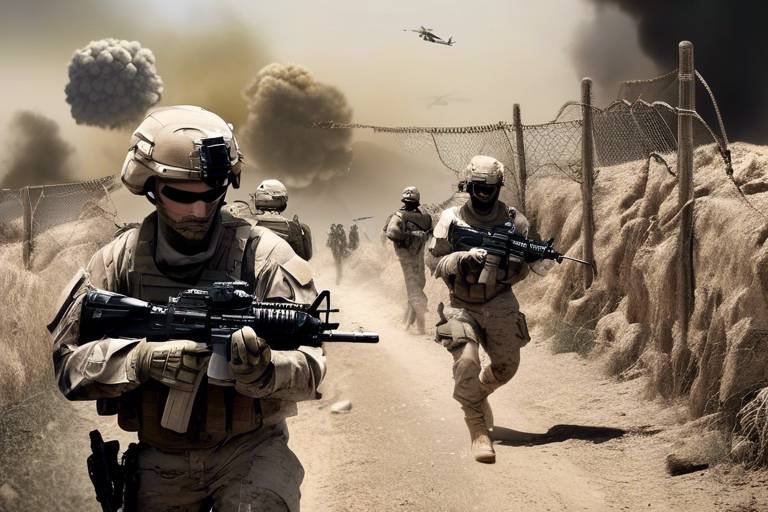The Importance of Data Analytics in Military Decision-Making
In an age where information is power, the military's ability to leverage data analytics is nothing short of revolutionary. Imagine being able to sift through mountains of data to find critical insights that can save lives and ensure mission success. This is the essence of data analytics in military decision-making. By employing sophisticated analytical techniques, military leaders can enhance their strategies, improve operational efficiency, and make informed decisions in real-time. The stakes are incredibly high, and the margin for error is razor-thin. Thus, the integration of data analytics into military operations is not merely beneficial; it is essential for navigating the complexities of modern warfare.
Data analytics serves as the backbone of military strategy today. It transforms raw data into actionable intelligence, which is crucial for operational planning and strategic assessments. Think of it as a high-tech compass guiding military leaders through the fog of war. With the right data analysis tools, commanders can anticipate enemy movements, assess risks, and allocate resources more effectively. This proactive approach not only helps in planning missions but also in executing them with finesse and precision.
Moreover, the sheer volume of data generated in military operations is staggering. From intelligence reports to satellite imagery, the information available is both vast and varied. The challenge lies in harnessing this big data effectively. Military leaders must be adept at filtering through this information to extract insights that matter. This is where advanced analytics come into play, allowing for the identification of patterns and trends that may not be immediately apparent. By doing so, military forces can stay one step ahead of potential threats, ensuring a strategic advantage on the battlefield.
In conclusion, the importance of data analytics in military decision-making cannot be overstated. As military operations become increasingly complex, the need for informed, data-driven decisions is paramount. By embracing data analytics, military leaders can enhance their strategic capabilities, improve operational efficiency, and ultimately achieve more effective outcomes in challenging environments. The future of military operations will undoubtedly be shaped by the ability to analyze and act on data swiftly and accurately, making data analytics not just a tool, but a critical component of modern warfare.
- What is data analytics in the military context?
Data analytics in the military involves examining and interpreting vast amounts of data to derive actionable insights that inform strategic and operational decisions. - How does big data impact military operations?
Big data enables military leaders to anticipate challenges, assess risks, and make informed decisions by analyzing large volumes of information from various sources. - What are the main data sources used in military analytics?
Key data sources include intelligence reports, satellite imagery, and social media, which collectively provide a comprehensive view of the operational environment. - What role do predictive analytics play in military decision-making?
Predictive analytics use historical data to forecast future events, helping military leaders anticipate enemy actions and prepare responses accordingly. - What challenges are faced in implementing data analytics in the military?
Challenges include data security concerns, integration of legacy systems, and the need for skilled personnel to interpret complex data.

Understanding Data Analytics
Data analytics is like a treasure map for military strategists; it helps uncover hidden insights buried within layers of raw data. Imagine sifting through vast amounts of information, searching for patterns and trends that can inform critical decisions. In the military context, this process is not just beneficial—it’s essential. By examining data meticulously, military leaders can gain a clearer understanding of their operational landscape, enabling them to plan effectively and respond to challenges with agility.
At its core, data analytics involves several key steps: collecting data, processing it, analyzing the results, and finally, interpreting those results to inform decisions. This cycle is crucial for operational planning and strategic assessments. Think of it as a well-oiled machine where each cog plays a vital role in ensuring that the military can operate at peak efficiency. By leveraging data analytics, commanders can transform raw data into actionable insights that can dictate the outcome of missions.
Moreover, the military is increasingly finding ways to integrate advanced technologies into data analytics. For instance, the use of artificial intelligence (AI) and machine learning algorithms allows for more sophisticated analysis, enabling the military to predict enemy movements and assess risks in real-time. The combination of these technologies with traditional data sources creates a robust framework for decision-making.
To illustrate this further, let’s consider some of the primary components of data analytics in the military:
- Data Collection: Gathering information from various sources, such as intelligence reports and surveillance data.
- Data Processing: Cleaning and organizing the data for analysis to ensure accuracy and reliability.
- Data Analysis: Utilizing statistical methods and algorithms to uncover trends and insights.
- Data Interpretation: Making sense of the analyzed data to inform strategic decisions.
In essence, understanding data analytics is about recognizing its potential to enhance military effectiveness. With the right tools and methodologies, military leaders can not only react to situations but also anticipate them. This proactive approach is what sets modern military operations apart from traditional strategies, making data analytics an indispensable asset in today’s complex and ever-changing battlefield.
- What is data analytics in the military? Data analytics in the military refers to the process of examining raw data to uncover patterns and insights that inform strategic and operational decisions.
- How does big data impact military operations? Big data provides vast amounts of information that military leaders can analyze to make informed decisions, anticipate challenges, and improve operational efficiency.
- What are some common data sources used in military analytics? Common data sources include intelligence reports, satellite imagery, and social media, all of which contribute to a comprehensive understanding of the operational environment.

The Role of Big Data in Military Operations
In today's fast-paced world, big data plays a pivotal role in shaping military operations. The sheer volume of data generated daily—from satellite imagery to intelligence reports—provides a treasure trove of information that can significantly enhance decision-making processes. Imagine trying to navigate a complex battlefield without a map; that's what military leaders face without effective data analytics. Big data allows them to transform raw information into actionable insights, giving them the upper hand in various operational scenarios.
To fully grasp the impact of big data in military operations, it's essential to understand the different dimensions of data it encompasses. This includes not only traditional data sources but also emerging technologies that collect and analyze information in real-time. By leveraging these data sources, military organizations can achieve several key objectives:
- Enhanced Situational Awareness: With big data analytics, commanders can access a comprehensive view of the battlefield, including enemy movements and environmental conditions.
- Improved Resource Allocation: Analyzing data allows for better distribution of resources, ensuring that troops and equipment are deployed where they are most needed.
- Faster Decision-Making: Real-time data analysis enables swift responses to changing conditions, which is crucial in high-stakes environments.
Moreover, big data analytics empowers military leaders to anticipate potential challenges and prepare accordingly. By utilizing predictive analytics, they can forecast enemy actions based on historical data patterns. This predictive capability is akin to having a crystal ball that reveals possible future scenarios, allowing military strategists to devise effective countermeasures.
However, the benefits of big data don't come without their challenges. Military organizations must navigate the complexities of data integration, ensuring that disparate data sources work harmoniously together. Additionally, the ability to interpret vast amounts of data requires skilled personnel who can make sense of the numbers and translate them into actionable strategies. It's a bit like having a powerful engine; without a skilled driver, you might not get very far.
In conclusion, big data is not just a buzzword in military operations; it's a game-changer. As military leaders continue to embrace data analytics, they will undoubtedly enhance their operational efficiency and effectiveness, ultimately leading to better outcomes in the field. The future of military strategy is here, and it’s fueled by the power of big data.
- What is big data in military operations?
Big data refers to the vast amounts of information collected from various sources that can be analyzed to improve decision-making and operational efficiency in military contexts. - How does big data enhance situational awareness?
By integrating and analyzing data from multiple sources, military leaders can gain a comprehensive view of the battlefield, including enemy movements and environmental factors. - What are the challenges of implementing big data analytics in the military?
Challenges include data security concerns, the integration of legacy systems, and the need for skilled personnel to interpret complex data.

Data Sources in Military Context
In the realm of military operations, the importance of data sources cannot be overstated. These sources serve as the backbone for strategic planning and execution, providing vital information that shapes decision-making processes. Military data sources encompass a wide array of information, including intelligence reports, satellite imagery, and even social media analytics. Each of these sources plays a unique role in creating a comprehensive operational picture, which is essential for success in complex environments.
To begin with, intelligence reports are fundamental in understanding the enemy's capabilities and movements. These reports are often compiled from various inputs, including human intelligence (HUMINT), signals intelligence (SIGINT), and open-source intelligence (OSINT). By analyzing these reports, military leaders can enhance their situational awareness, enabling them to anticipate potential threats and respond effectively. For instance, a well-timed intelligence report can mean the difference between a successful operation and a catastrophic failure.
Next, we have satellite imagery, which provides real-time visual data that is crucial for operational planning. With the advancement of technology, military satellites can capture high-resolution images of the battlefield, allowing commanders to assess terrain features and enemy positions from above. This capability not only aids in strategic planning but also enhances tactical decisions during missions. Imagine trying to navigate a dense forest without a map; satellite imagery acts as that map, guiding military personnel through the fog of war.
Moreover, social media has emerged as an unexpected yet valuable data source in military contexts. Platforms like Twitter and Facebook can provide real-time updates on public sentiment and enemy movements. By monitoring social media, military analysts can gauge the morale of local populations and identify potential threats or unrest. This type of analysis can be likened to having a window into the minds of the people in the area of operations, offering insights that traditional intelligence methods may overlook.
In summary, the integration of these diverse data sources allows military leaders to create a well-rounded operational picture. Each source complements the others, providing a multi-faceted view of the battlefield. As military operations become increasingly complex, the ability to harness and analyze data from various sources will be paramount for success. The future of military strategy lies in the ability to adapt and respond to an ever-evolving landscape of information.
- What are the main data sources used in military operations?
Military operations rely on intelligence reports, satellite imagery, and social media analytics to inform decision-making and operational planning. - How do intelligence reports enhance military strategies?
Intelligence reports provide critical insights into enemy movements and capabilities, allowing military leaders to make informed decisions and improve situational awareness. - Why is satellite imagery important for military operations?
Satellite imagery offers real-time visual data that helps assess terrain and enemy positions, which is essential for effective strategic planning. - Can social media really impact military decision-making?
Yes, social media can provide valuable real-time updates on public sentiment and potential threats, enhancing the overall understanding of the operational environment.

Intelligence Reports
Intelligence reports are the backbone of military operations, providing critical insights that can make or break a mission. These reports are meticulously compiled from various sources, including human intelligence (HUMINT), signals intelligence (SIGINT), and open-source intelligence (OSINT). Each type of intelligence contributes unique perspectives, allowing military leaders to form a well-rounded understanding of the battlefield. Imagine trying to solve a puzzle; without all the pieces, the picture remains incomplete. Similarly, intelligence reports fill in the gaps, revealing the capabilities and movements of enemy forces.
Analyzing intelligence reports enhances situational awareness, enabling commanders to foresee potential threats and opportunities. For instance, if a report indicates unusual troop movements near a border, military leaders can assess whether this is a sign of an impending attack or a routine exercise. This timely analysis is crucial, as it allows for rapid decision-making and strategic adjustments. The importance of these reports cannot be overstated—failure to act on critical intelligence can lead to devastating consequences, akin to ignoring a smoke signal when a fire is approaching.
Furthermore, intelligence reports come with a degree of uncertainty. Military analysts use various methodologies to evaluate the reliability of the information they receive. They often categorize intelligence based on its source, timeliness, and corroboration with other data. This process helps in filtering out noise and focusing on actionable insights. For example, a report from a trusted informant may carry more weight than a rumor circulating on social media. To illustrate this, consider the following table that outlines the factors influencing the credibility of intelligence reports:
| Factor | Description |
|---|---|
| Source Reliability | How trustworthy is the source of the intelligence? |
| Timeliness | Is the information current, or is it outdated? |
| Corroboration | Does the information match other intelligence reports? |
| Context | What is the situation surrounding the intelligence? |
In conclusion, intelligence reports are indispensable in military decision-making. They offer a wealth of information that, when properly analyzed, can lead to informed strategies and successful operations. The ability to interpret these reports accurately is a skill that military personnel must hone continuously, as the stakes are incredibly high. Ultimately, the effectiveness of military operations hinges on the quality of intelligence and the speed at which it is processed.
- What are intelligence reports?
Intelligence reports are documents that provide critical information about enemy activities, capabilities, and intentions, compiled from various intelligence sources.
- How are intelligence reports used in military operations?
They are used to enhance situational awareness, inform strategic planning, and support decision-making processes in real-time.
- What types of intelligence contribute to these reports?
Key types include human intelligence (HUMINT), signals intelligence (SIGINT), and open-source intelligence (OSINT).
- Why is the credibility of intelligence reports important?
The credibility affects how military leaders interpret and act on the information, which can significantly impact mission success.

Satellite Imagery
This article explores how data analytics enhances military strategies, improves operational efficiency, and aids in real-time decision-making, ultimately leading to more effective outcomes in complex military environments.
Data analytics involves examining raw data to uncover patterns, trends, and insights that inform decisions. In the military context, this process is crucial for operational planning and strategic assessments.
Big data refers to the vast volumes of data generated daily. Understanding how to harness this information is essential for military leaders to make informed decisions and anticipate challenges.
Military data sources include intelligence reports, satellite imagery, and social media. Analyzing these diverse datasets helps in creating a comprehensive picture of the operational environment.
Intelligence reports provide critical information about enemy movements and capabilities. Analyzing these reports enhances situational awareness and supports timely decision-making.
Satellite imagery offers a powerful tool for military operations, providing commanders with real-time visual data that is essential for strategic planning. By utilizing high-resolution images captured from space, military leaders can gain valuable insights into various terrains and enemy positions. This visual data can be used to:
- Assess Terrain Features: Understanding the geography of an area is crucial for mission planning. Satellite imagery allows for the identification of natural obstacles, potential ambush sites, and advantageous positions for troop deployment.
- Monitor Enemy Movements: By analyzing changes in satellite images over time, military analysts can detect patterns in enemy troop movements, supply routes, and logistical support, enabling proactive strategies.
- Evaluate Damage Assessment: Post-operation analysis can be conducted using satellite imagery to assess the impact of military actions, helping to refine future strategies and operations.
The integration of satellite imagery with data analytics tools enhances the ability to interpret vast amounts of visual data quickly and accurately. For instance, machine learning algorithms can be employed to identify specific patterns in the imagery, such as the presence of vehicles or changes in infrastructure. This capability not only speeds up the decision-making process but also increases the accuracy of the intelligence gathered.
Moreover, the collaboration between satellite imagery and other data sources, like intelligence reports and social media, creates a more comprehensive operational picture. Imagine piecing together a jigsaw puzzle where each piece represents a different data source; the final image becomes clearer and more detailed as more pieces are added. This holistic view is crucial in modern warfare, where the stakes are high and decisions must be made swiftly.
Various tools and technologies are utilized in military data analytics, ranging from machine learning algorithms to data visualization software, aiding in efficient data processing and interpretation.
Data analytics significantly improves decision-making processes in military operations. By providing actionable insights, it allows commanders to evaluate options and outcomes more effectively.
Predictive analytics uses historical data to forecast future events. In military contexts, this can help anticipate enemy actions and prepare responses accordingly.
Real-time data analysis enables military leaders to make swift decisions based on current information. This immediacy is vital in dynamic combat situations where circumstances can change rapidly.
Despite its advantages, implementing data analytics in the military faces challenges such as data security, integration of systems, and the need for skilled personnel to interpret complex data.
Data security is paramount in military operations. Protecting sensitive information from cyber threats is essential to maintain operational integrity and national security.
Many military organizations still rely on legacy systems. Integrating modern analytics tools with these older systems poses significant challenges but is necessary for improved decision-making capabilities.
- What is data analytics in the military?
Data analytics in the military involves examining and interpreting vast amounts of data to enhance operational planning and strategic decision-making.
- How does satellite imagery aid military operations?
Satellite imagery provides real-time visual data that helps assess terrain, monitor enemy movements, and evaluate the impact of military actions.
- What are the challenges of implementing data analytics in the military?
Challenges include data security concerns, the integration of legacy systems, and the need for skilled personnel to interpret complex data.
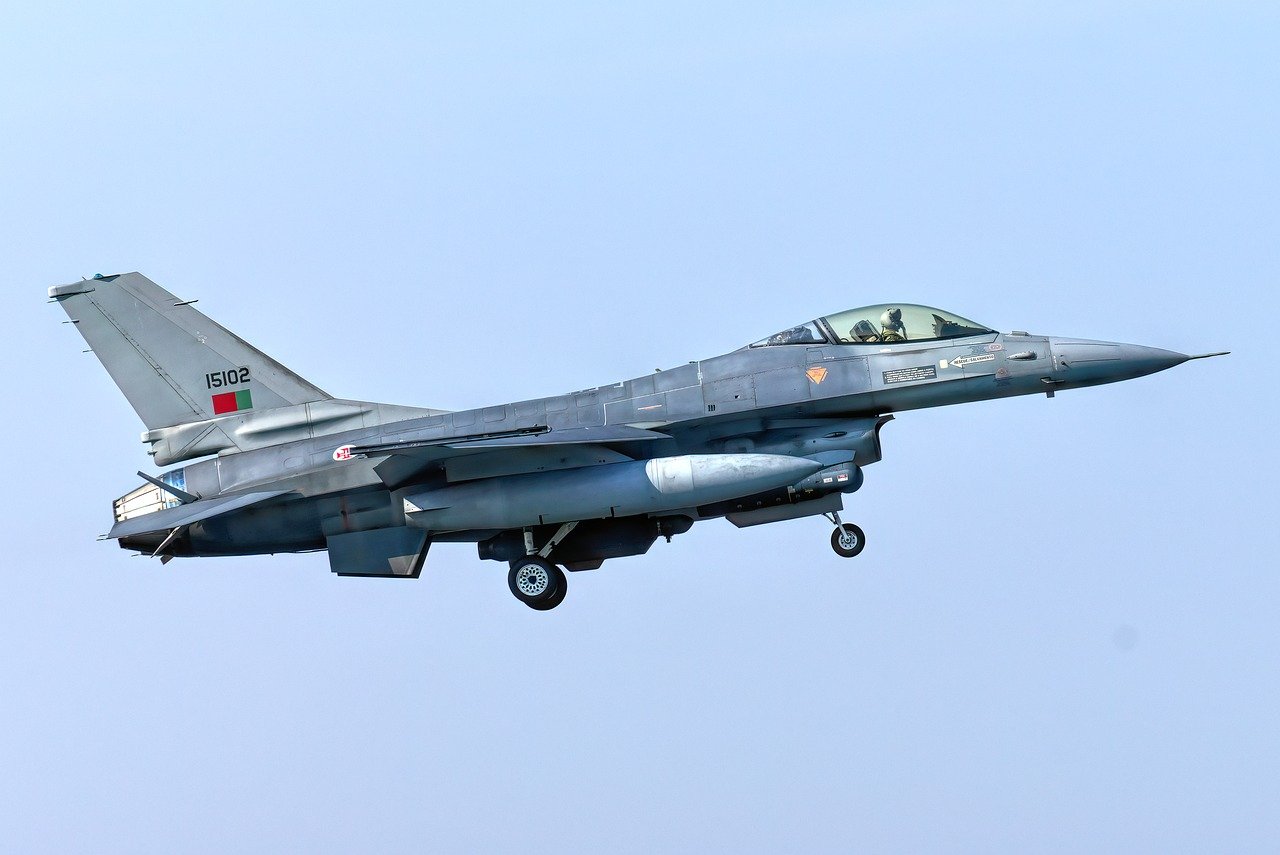
Data Analytics Tools and Technologies
In the fast-paced world of military operations, have become indispensable. These tools not only streamline the process of analyzing vast amounts of data but also enhance the accuracy of the insights derived from it. Imagine a military commander standing on the battlefield, equipped with a powerful toolkit that allows them to sift through mountains of information in seconds. This is the reality that modern analytics technologies bring to the table.
Among the most prominent tools used in military data analytics are machine learning algorithms, which are designed to recognize patterns and make predictions based on historical data. These algorithms can analyze past engagements, troop movements, and even enemy strategies to provide actionable insights. For instance, by feeding historical data into these systems, military analysts can forecast potential enemy actions and prepare countermeasures in advance. This predictive capability is akin to having a crystal ball that offers a glimpse into the future of military engagements.
Another critical component of military data analytics is data visualization software. This software transforms complex datasets into intuitive visual formats, making it easier for commanders to grasp essential information at a glance. Think of it as turning a dense textbook into a colorful infographic. With tools like heat maps, dashboards, and 3D terrain models, military leaders can quickly understand the operational landscape and make informed decisions on the fly. The visual representation of data not only aids in comprehension but also enhances communication among team members, ensuring everyone is on the same page.
Moreover, cloud computing has revolutionized the way military organizations store and access data. By leveraging cloud technologies, military units can share information in real-time across various locations, breaking down barriers that previously hindered collaboration. This capability is especially crucial during joint operations, where multiple branches of the military need to work together seamlessly. The cloud serves as a centralized hub for data, allowing for rapid updates and ensuring that all stakeholders have access to the most current information.
As we delve deeper into the technological landscape, it is essential to recognize the role of artificial intelligence (AI) in enhancing data analytics. AI systems can automate routine tasks, analyze data at lightning speed, and even provide recommendations based on complex algorithms. For example, AI can assist in monitoring social media channels for real-time intelligence, helping military personnel stay ahead of potential threats. The integration of AI into military analytics represents a significant leap forward, enabling faster and more accurate decision-making.
In summary, the landscape of military data analytics is shaped by a variety of tools and technologies that enhance operational efficiency and strategic planning. From machine learning algorithms to data visualization software, these innovations empower military leaders with the insights they need to navigate complex environments. As technology continues to evolve, we can expect even more sophisticated tools to emerge, further transforming the way military operations are conducted.
- What is data analytics in the military context? Data analytics in the military involves examining data from various sources to gain insights that inform operational planning and strategic assessments.
- How does big data impact military decision-making? Big data provides military leaders with vast amounts of information that, when analyzed, can lead to more informed and timely decisions.
- What are the main tools used for data analytics in the military? Key tools include machine learning algorithms, data visualization software, cloud computing, and artificial intelligence.
- What challenges does the military face in implementing data analytics? Challenges include data security concerns, the integration of legacy systems, and the need for skilled personnel to interpret complex data.
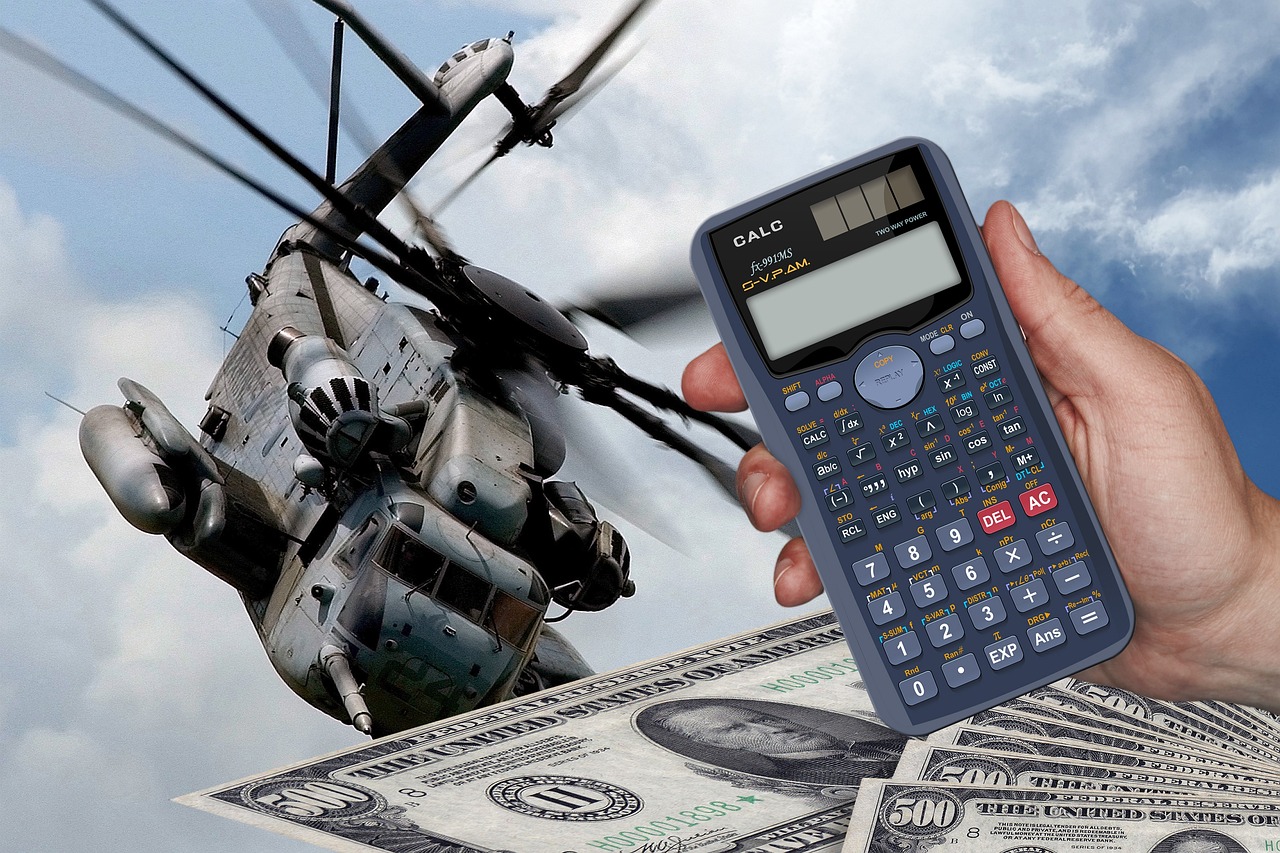
Enhancing Decision-Making Processes
Data analytics is revolutionizing the way military leaders approach decision-making. Imagine being in a high-stakes situation where every second counts; the ability to quickly analyze data can mean the difference between success and failure. By harnessing the power of data analytics, military commanders can sift through vast amounts of information to uncover actionable insights that lead to informed choices. This process not only streamlines decision-making but also enhances the overall effectiveness of military operations.
One of the key benefits of data analytics is its ability to provide a clearer picture of the battlefield. For instance, through the analysis of various data streams, commanders can assess potential outcomes of different strategies. This is particularly crucial in environments where uncertainty reigns supreme. By evaluating multiple scenarios and their potential impacts, military leaders can select the most advantageous course of action. In essence, data analytics acts as a sophisticated compass, guiding decision-makers through the fog of war.
Moreover, the integration of predictive analytics into military operations allows leaders to forecast future events based on historical data. This capability is invaluable; it provides a glimpse into possible enemy actions and enables proactive planning. Think of it as having a crystal ball that helps anticipate threats before they materialize. For example, if past data indicates a pattern of enemy movements during certain times, commanders can prepare and position their forces accordingly, thus gaining a tactical edge.
Real-time data analysis is another game-changer in military decision-making. In the heat of battle, situations can evolve in the blink of an eye. The ability to analyze data as it comes in allows military leaders to make rapid decisions based on the most current information available. This immediacy is like having a live feed of the battlefield, enabling commanders to respond to changing conditions swiftly. Whether it’s adjusting troop movements or reallocating resources, real-time data analysis ensures that decisions are made with the latest insights at hand.
However, enhancing decision-making processes through data analytics is not without its challenges. Military organizations must navigate issues such as data security, ensuring that sensitive information remains protected from cyber threats. Additionally, the integration of modern analytics tools with existing systems can be complex, particularly for those still relying on outdated technologies. It’s essential for military leaders to invest in both technology and training to overcome these hurdles and fully leverage the power of data analytics.
In conclusion, the incorporation of data analytics into military decision-making processes is transforming how strategies are formulated and executed. By providing actionable insights, predictive capabilities, and real-time analysis, data analytics empowers military leaders to make informed decisions that can significantly enhance operational effectiveness. As the military continues to embrace these advancements, the potential for improved outcomes in complex environments becomes increasingly promising.
- What is data analytics in a military context?
Data analytics in the military involves examining raw data to uncover patterns and insights that inform strategic decisions and operational planning. - How does predictive analytics benefit military operations?
Predictive analytics helps anticipate enemy actions by analyzing historical data, allowing military leaders to prepare and respond effectively. - What are the challenges of implementing data analytics in the military?
Challenges include data security concerns, integration with legacy systems, and the need for skilled personnel to interpret complex data. - Why is real-time data analysis important in military decision-making?
Real-time data analysis allows military leaders to make swift, informed decisions based on the most current information, which is crucial in dynamic combat situations.

Predictive Analytics
Predictive analytics is like having a crystal ball in the military realm. It takes a look at historical data and uses sophisticated statistical algorithms and machine learning techniques to forecast future events. Imagine being able to anticipate an enemy's next move before they even make it! This capability is crucial in military contexts where uncertainty and rapid changes are the norms. By analyzing patterns from past operations, military leaders can develop strategic responses that are not just reactive but proactive.
For instance, consider a scenario where a military unit is deployed in a region known for insurgent activities. By utilizing predictive analytics, commanders can analyze historical data on insurgent behavior, movements, and attacks. This analysis can reveal trends, such as specific times or locations where attacks are more likely to occur. Armed with this knowledge, military leaders can allocate resources more effectively, deploy troops in a manner that maximizes safety, and even conduct preemptive operations to disrupt potential threats.
The power of predictive analytics doesn't stop at anticipating enemy actions. It can also be applied to logistical planning, personnel management, and resource allocation. By forecasting supply chain needs or potential personnel shortages, military organizations can ensure that they are always prepared for various scenarios. This leads to enhanced operational efficiency and a significant reduction in risks associated with unforeseen challenges.
However, to harness the full potential of predictive analytics, military organizations must invest in the right technologies and training. The integration of advanced analytics tools with existing systems is essential, as is the development of a workforce skilled in data interpretation. Only then can the military truly leverage predictive analytics to enhance decision-making processes and operational effectiveness.
In summary, predictive analytics is a game-changer for military decision-making. By turning data into actionable insights, it empowers commanders to make informed choices that can significantly influence the outcome of operations. As the military continues to evolve in the digital age, the importance of predictive analytics will only grow, shaping the future of strategic planning and execution.
- What is predictive analytics?
Predictive analytics involves using historical data, statistical algorithms, and machine learning techniques to identify the likelihood of future outcomes based on past events.
- How does predictive analytics benefit military operations?
It helps military leaders anticipate enemy movements, optimize resource allocation, and improve logistical planning, ultimately enhancing operational effectiveness.
- What challenges are associated with implementing predictive analytics in the military?
Challenges include data security concerns, integration with legacy systems, and the need for skilled personnel to analyze and interpret complex data.

Real-Time Data Analysis
This article explores how data analytics enhances military strategies, improves operational efficiency, and aids in real-time decision-making, ultimately leading to more effective outcomes in complex military environments.
Data analytics involves examining raw data to uncover patterns, trends, and insights that inform decisions. In the military context, this process is crucial for operational planning and strategic assessments.
Big data refers to the vast volumes of data generated daily. Understanding how to harness this information is essential for military leaders to make informed decisions and anticipate challenges.
Military data sources include intelligence reports, satellite imagery, and social media. Analyzing these diverse datasets helps in creating a comprehensive picture of the operational environment.
Intelligence reports provide critical information about enemy movements and capabilities. Analyzing these reports enhances situational awareness and supports timely decision-making.
Satellite imagery offers real-time visual data for military operations. By analyzing these images, commanders can assess terrain and enemy positions, leading to better strategic planning.
Various tools and technologies are utilized in military data analytics, ranging from machine learning algorithms to data visualization software, aiding in efficient data processing and interpretation.
Data analytics significantly improves decision-making processes in military operations. By providing actionable insights, it allows commanders to evaluate options and outcomes more effectively.
Predictive analytics uses historical data to forecast future events. In military contexts, this can help anticipate enemy actions and prepare responses accordingly.
Real-time data analysis is like having a crystal ball for military leaders. Imagine being able to see the battlefield as it unfolds, with information flowing in at lightning speed. This capability enables commanders to make swift decisions based on current information, which is vital in dynamic combat situations where circumstances can change rapidly. For instance, if a unit encounters unexpected enemy resistance, real-time data analysis allows leaders to quickly assess the situation, evaluate troop movements, and deploy reinforcements without missing a beat.
Moreover, the integration of technology such as drones and satellite systems enhances the effectiveness of real-time data analysis. These tools provide a constant stream of information regarding troop locations, enemy positions, and environmental conditions. With this data at their fingertips, military leaders can:
- Adjust strategies on the fly: When faced with unforeseen challenges, real-time analysis allows for immediate tactical adjustments.
- Communicate effectively: Instantaneous updates ensure that all units are on the same page, reducing confusion and enhancing coordination.
- Minimize risks: By having up-to-the-minute information, commanders can make informed decisions that reduce the likelihood of casualties and mission failures.
In essence, real-time data analysis transforms the way military operations are conducted. It empowers leaders to act decisively and effectively, ultimately leading to better outcomes in the field.
Despite its advantages, implementing data analytics in the military faces challenges such as data security, integration of systems, and the need for skilled personnel to interpret complex data.
Data security is paramount in military operations. Protecting sensitive information from cyber threats is essential to maintain operational integrity and national security.
Many military organizations still rely on legacy systems. Integrating modern analytics tools with these older systems poses significant challenges but is necessary for improved decision-making capabilities.
- What is data analytics in the military? Data analytics in the military involves analyzing vast amounts of data to gain insights that inform strategic and operational decisions.
- How does real-time data analysis benefit military operations? Real-time data analysis allows military leaders to make informed decisions quickly, enhancing situational awareness and operational effectiveness.
- What are the main challenges in implementing data analytics in the military? Key challenges include data security, system integration, and the need for skilled personnel to interpret complex data.

Challenges in Implementing Data Analytics
Implementing data analytics in military operations is not without its hurdles. While the advantages are clear, the path to effective integration is often fraught with challenges that require careful navigation. One of the most pressing issues is data security. In an age where cyber threats are rampant, safeguarding sensitive military information is crucial. A breach can not only compromise missions but also endanger lives. Therefore, military organizations must invest heavily in robust cybersecurity measures to protect their data assets.
Another significant challenge is the integration of legacy systems. Many military branches still rely on outdated technology that is not compatible with modern analytics tools. This can lead to inefficiencies and gaps in data interpretation. For instance, if data from a legacy system cannot be easily accessed or analyzed, it may result in missed opportunities for timely decision-making. Thus, transitioning to more advanced systems while maintaining operational continuity becomes a delicate balancing act.
Moreover, there is a critical need for skilled personnel who can interpret complex data sets. Military organizations often face a shortage of qualified analysts who are adept at using sophisticated data analytics tools. This gap can hinder the effective utilization of data analytics in decision-making processes. Training existing personnel or recruiting new talent is essential, but it requires time and resources that may not always be readily available.
Additionally, the sheer volume of data generated daily can be overwhelming. The military must sift through vast amounts of information from various sources, including intelligence reports, satellite imagery, and social media. Managing this big data effectively is a challenge in itself. Without proper filtering and prioritization, critical insights may be lost in the noise, leading to less informed decisions.
Lastly, there is often a cultural resistance to change within military organizations. Traditional decision-making processes may be deeply ingrained, and introducing data-driven approaches can meet with skepticism. Overcoming this resistance requires a concerted effort to demonstrate the value of data analytics in enhancing operational effectiveness and achieving strategic goals.
| Challenge | Description |
|---|---|
| Data Security | Protecting sensitive information from cyber threats is crucial for operational integrity. |
| Integration of Legacy Systems | Outdated technology can hinder the compatibility with modern analytics tools. |
| Skilled Personnel | A shortage of qualified analysts can limit effective data interpretation. |
| Big Data Management | Sifting through vast amounts of data can lead to critical insights being overlooked. |
| Cultural Resistance | Traditional decision-making processes may resist the adoption of data-driven approaches. |
- What is data analytics in a military context?
Data analytics involves examining raw data to uncover patterns and insights that inform military decisions. - Why is data security important in military operations?
Data security is crucial to protect sensitive information from cyber threats, ensuring operational integrity and national security. - What are legacy systems, and why are they a challenge?
Legacy systems are outdated technologies that may not be compatible with modern data analytics tools, hindering effective data processing. - How can military organizations overcome the challenges of implementing data analytics?
By investing in cybersecurity, upgrading technology, training personnel, and fostering a culture that embraces data-driven decision-making.

Data Security Concerns
In the realm of military operations, data security is not just a technical issue; it’s a matter of national security. The military deals with sensitive information that, if compromised, could lead to catastrophic consequences. Imagine a chess game where your opponent knows your every move—this is the reality of inadequate data security. The stakes are incredibly high, and the need to protect data from cyber threats is more crucial than ever.
With the increasing reliance on technology and data analytics, the military must navigate a complex landscape of potential vulnerabilities. Cybersecurity threats can come from various sources, including foreign adversaries and rogue hackers. As military operations become more digitized, the methods to breach security measures also evolve, making it imperative for military leaders to stay one step ahead.
To effectively tackle these security concerns, military organizations must implement robust cybersecurity measures. This includes:
- Encryption: Protecting data in transit and at rest through advanced encryption technologies.
- Access Controls: Ensuring that only authorized personnel have access to sensitive information.
- Regular Audits: Conducting frequent security audits to identify and mitigate vulnerabilities.
- Training Personnel: Educating military staff on cybersecurity best practices to foster a culture of security awareness.
Moreover, the integration of advanced technologies such as artificial intelligence (AI) can enhance the ability to detect and respond to threats in real-time. By leveraging AI, military organizations can analyze patterns of behavior that may indicate a breach, allowing for a quicker response and minimizing potential damage.
However, the implementation of these security measures does not come without challenges. The military must balance the need for operational efficiency with the necessity of stringent security protocols. This often leads to a tension between accessibility and security. For instance, while it’s essential for commanders to have access to real-time data, overly restrictive security measures can hinder their ability to make swift decisions in critical situations.
In conclusion, addressing data security concerns in military operations is a multifaceted endeavor that requires constant vigilance, innovative solutions, and a proactive approach. As cyber threats continue to evolve, so must the strategies to combat them. The military must not only protect its data but also ensure that the systems in place are resilient enough to withstand potential attacks.
- What are the main data security concerns in military operations?
The primary concerns include protection against cyber threats, unauthorized access to sensitive information, and the integrity of data systems. - How can military organizations enhance data security?
By implementing encryption, access controls, regular audits, and training personnel on cybersecurity best practices. - What role does AI play in military data security?
AI can help detect and respond to cybersecurity threats in real-time, improving the overall security posture of military operations. - Why is data security crucial for military decision-making?
Compromised data can lead to operational failures and endanger national security, making data security a top priority for military leaders.

Integration of Legacy Systems
This article explores how data analytics enhances military strategies, improves operational efficiency, and aids in real-time decision-making, ultimately leading to more effective outcomes in complex military environments.
Data analytics involves examining raw data to uncover patterns, trends, and insights that inform decisions. In the military context, this process is crucial for operational planning and strategic assessments.
Big data refers to the vast volumes of data generated daily. Understanding how to harness this information is essential for military leaders to make informed decisions and anticipate challenges.
Military data sources include intelligence reports, satellite imagery, and social media. Analyzing these diverse datasets helps in creating a comprehensive picture of the operational environment.
Intelligence reports provide critical information about enemy movements and capabilities. Analyzing these reports enhances situational awareness and supports timely decision-making.
Satellite imagery offers real-time visual data for military operations. By analyzing these images, commanders can assess terrain and enemy positions, leading to better strategic planning.
Various tools and technologies are utilized in military data analytics, ranging from machine learning algorithms to data visualization software, aiding in efficient data processing and interpretation.
Data analytics significantly improves decision-making processes in military operations. By providing actionable insights, it allows commanders to evaluate options and outcomes more effectively.
Predictive analytics uses historical data to forecast future events. In military contexts, this can help anticipate enemy actions and prepare responses accordingly.
Real-time data analysis enables military leaders to make swift decisions based on current information. This immediacy is vital in dynamic combat situations where circumstances can change rapidly.
Despite its advantages, implementing data analytics in the military faces challenges such as data security, integration of systems, and the need for skilled personnel to interpret complex data.
Data security is paramount in military operations. Protecting sensitive information from cyber threats is essential to maintain operational integrity and national security.
Many military organizations still rely on legacy systems, which can pose significant challenges when trying to implement modern data analytics solutions. These older systems were not designed to handle the vast amounts of data generated today, and integrating them with new technologies can be like trying to fit a square peg in a round hole. The complexity of this integration can lead to various issues, including:
- Data Compatibility: Legacy systems may store data in outdated formats, making it difficult to extract and analyze the information using modern tools.
- Operational Disruption: Transitioning from old systems to new ones can cause temporary disruptions in operations, which is a major concern in the military context.
- Training Requirements: Personnel may need extensive training to adapt to new systems, which can take time and resources.
Despite these challenges, integrating legacy systems with modern analytics tools is necessary for improved decision-making capabilities. It requires a strategic approach that includes:
- Assessment of Existing Systems: Evaluating current systems to identify compatibility issues and data storage formats.
- Incremental Integration: Gradually implementing new tools while maintaining the old systems to minimize disruption.
- Continuous Training: Providing ongoing training for personnel to ensure they are comfortable with both legacy and new systems.
Ultimately, the successful integration of legacy systems with advanced data analytics tools can lead to enhanced operational efficiency and more informed decision-making in military operations.
- What is data analytics in the military? Data analytics in the military refers to the process of examining raw military data to uncover patterns and insights that can inform strategic decisions.
- Why is big data important for military operations? Big data is crucial as it helps military leaders make informed decisions by providing a comprehensive view of the operational environment.
- What are the challenges of integrating legacy systems? Challenges include data compatibility, potential operational disruption, and the need for training personnel on new systems.
Frequently Asked Questions
- What is data analytics in the military context?
Data analytics in the military involves examining vast amounts of raw data to identify patterns and trends that can inform strategic decisions. It plays a crucial role in operational planning and enhances situational awareness, allowing military leaders to make informed choices based on comprehensive insights.
- How does big data impact military operations?
Big data impacts military operations by providing an abundance of information that can be analyzed to improve decision-making. Military leaders can harness big data to anticipate challenges, assess risks, and develop strategies that are more effective in complex environments.
- What are the primary data sources used in military analytics?
The primary data sources in military analytics include intelligence reports, satellite imagery, and social media. By analyzing these diverse datasets, military organizations can create a detailed understanding of the operational environment, leading to better strategic outcomes.
- What role do predictive analytics play in military decision-making?
Predictive analytics play a vital role in military decision-making by using historical data to forecast potential future events. This capability allows military leaders to anticipate enemy actions and prepare their responses, enhancing overall operational effectiveness.
- What are some challenges of implementing data analytics in the military?
Implementing data analytics in the military comes with challenges such as ensuring data security, integrating modern analytics tools with legacy systems, and the need for skilled personnel who can interpret complex data. Addressing these challenges is essential for maximizing the benefits of data analytics.
- Why is data security a concern in military data analytics?
Data security is a major concern in military data analytics because protecting sensitive information from cyber threats is crucial for maintaining operational integrity and national security. Ensuring that data is secure helps prevent unauthorized access and potential breaches that could compromise missions.
- How can real-time data analysis benefit military operations?
Real-time data analysis benefits military operations by enabling leaders to make swift decisions based on the most current information available. This immediacy is critical in dynamic combat situations where circumstances can change rapidly, allowing for timely and effective responses.




